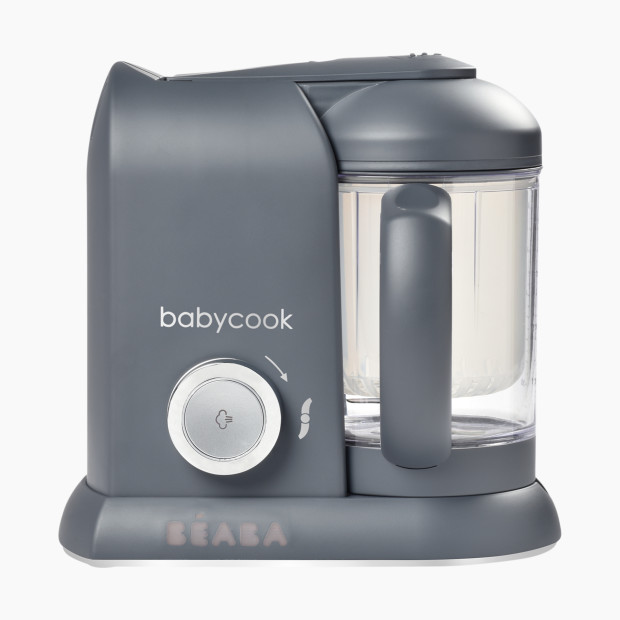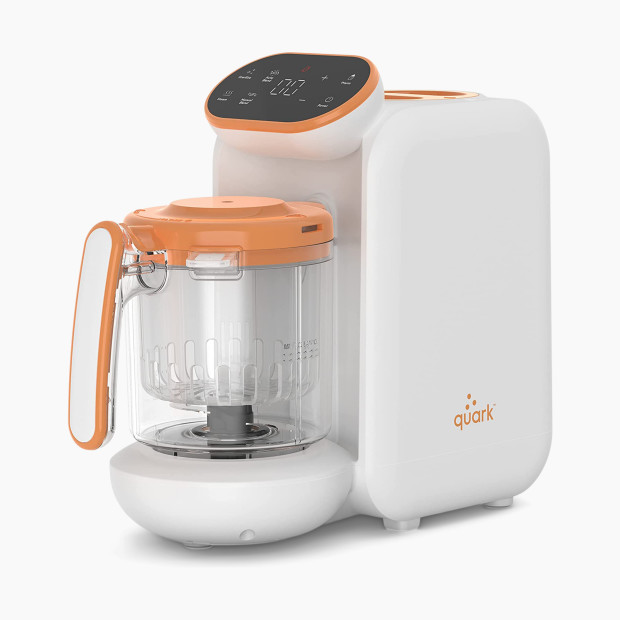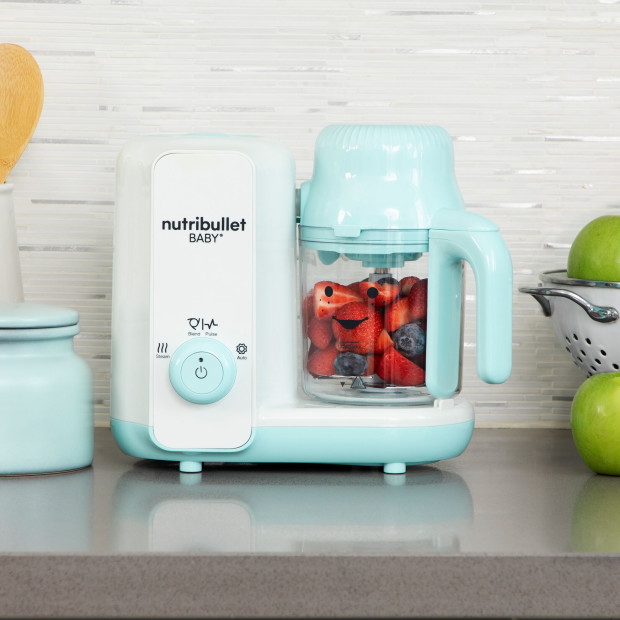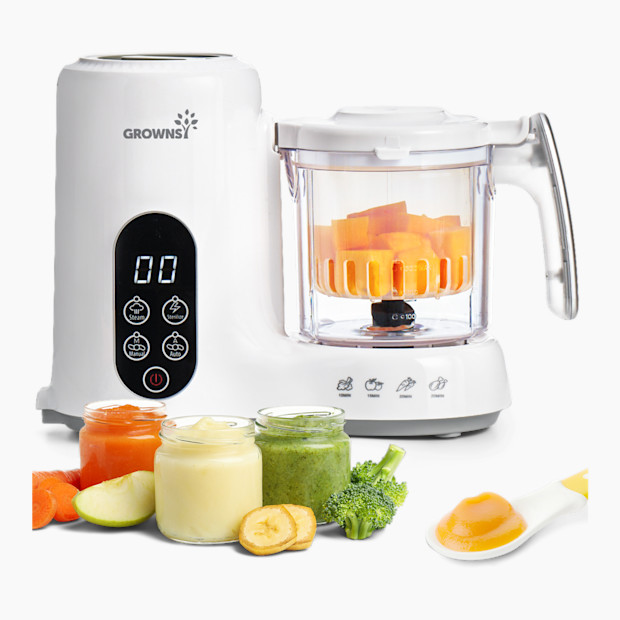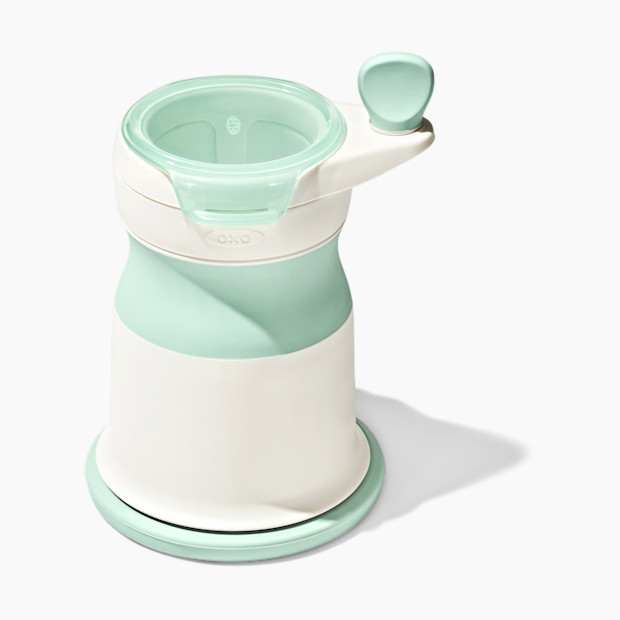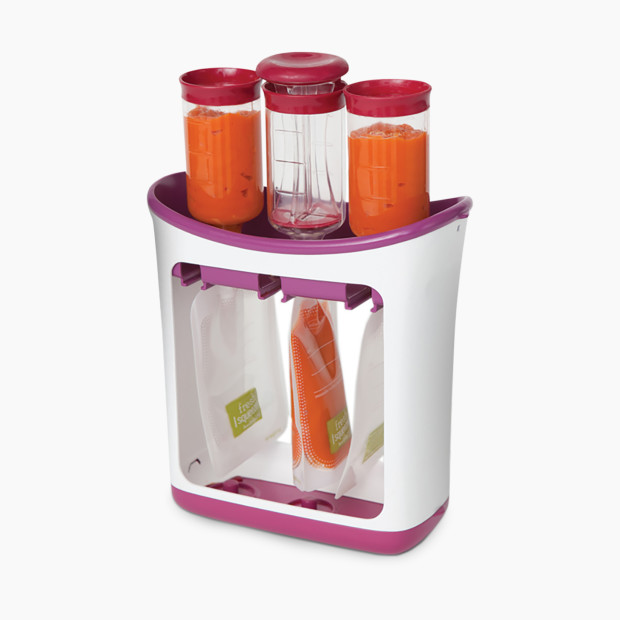
The Best Baby Food Makers to Make Prepping Solids Easier
Making healthy, homemade baby food is a lot easier than it sounds, especially with one of these.

By Jen LaBracio, CPST and Briana Engelbrecht
Fact Checked by Shannon Vestal Robson
In This Article
When you’re creating your registry, the idea of starting your baby on solid food may sound like it’s a long way off. But, as is the case with so many things when it comes to babies, time flies, and before you know it you’ll be thinking of what’s on the menu for baby’s first meal. There’s a lot of great baby food on the market, but many parents love the idea of making it themselves.
Baby food makers are a great solution for making the process of cooking homemade baby food for your little one fast, simple and even fun. After researching, testing and reading real parent reviews, Beaba Babycook Solo Baby Food Maker is our best overall pick for most families. It’s easy to use, works quickly and won’t take up a lot of counter space. We also chose a few food-making machines to give you more options, since every family has different needs. Let’s get cooking!
- Best All-in-One
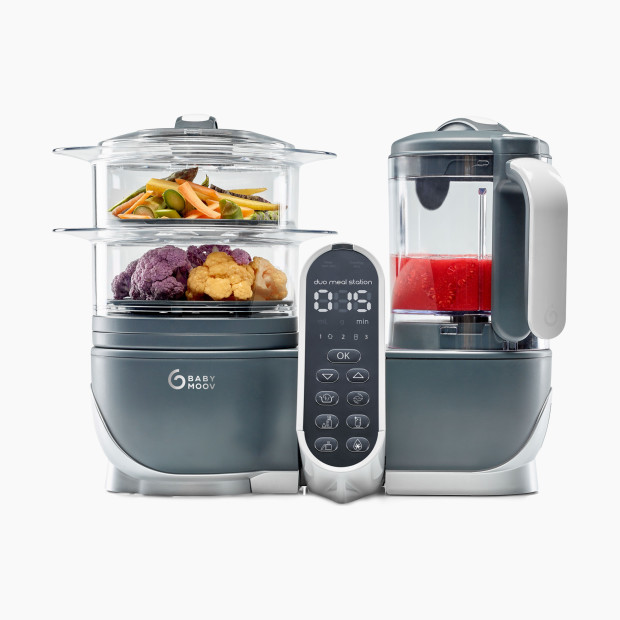 Babymoov Duo Meal Station 6-in-1 Food Prep System - Industrial GreyFrom $164.99
Babymoov Duo Meal Station 6-in-1 Food Prep System - Industrial GreyFrom $164.99 - Easiest to Use
 Baby Brezza One Step Food Maker Deluxe - Includes 3 Food PouchesFrom $129.99
Baby Brezza One Step Food Maker Deluxe - Includes 3 Food PouchesFrom $129.99 - Immersion Blender
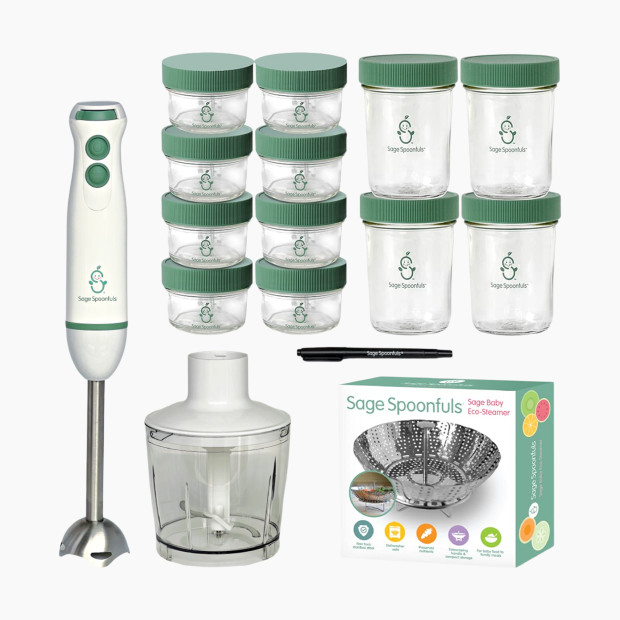 Sage Spoonfuls Baby Food Maker and Storage Set with Glass Jars - 17 PieceFrom $109.99
Sage Spoonfuls Baby Food Maker and Storage Set with Glass Jars - 17 PieceFrom $109.99
Why Trust Babylist?
Babylist is the expert in baby; we know baby gear inside and out. We talk with parents face-to-face in our showroom and on our user panels and hear from thousands annually via our Best Baby Products online survey. We know what items millions of expecting parents are adding to their baby registries.
First hand and professional experience. As a mom of two, I spent a lot of time researching all things solid food before I introduced it to my first, and then did it all over again when it was time for my second. Jen LaBracio, Babylist’s senior gear editor, is the original author of this guide, and I leaned on her initial research and insight when updating this piece.
Expert POV. Making sure your little one gets the right nutrients can feel daunting. For an expert point of view, I spoke with two pediatric nutrition experts. These include Alicia ‘Chacha’ Miller, a registered dietitian nutritionist and founder of The Cardamom and Danielle Zold, a pediatric registered dietitian, certified gastrointestinal nutritionist, certified lactation counselor, and founder of Nourished Pediatrics in Denver, Colorado.
Baby food maker data. I regularly analyze which baby products our users are adding to their baby registries the most (and which ones they aren’t) and what our team of Merchandising experts—our buyers who are responsible for ensuring the Babylist Shop is stocked with the best and newest gear—is excited about. Studying this kind of data helped us choose which food makers to narrow in on and which ones to recommend to new and expecting parents.
Feedback and reviews. I reviewed comments and feedback from Babylist’s annual product survey of thousands of parents, read customer reviews from hundreds of Babylist users and spoke to parents on our staff about their real-life product experiences.
How We Judged the Best Baby Food Makers
Best Baby Food Maker Overall
Beaba Babycook Solo Baby Food Maker - Charcoal
From $159.95Pros
- Easy to use and clean
- Convenient and quick
- Compact
Cons
- No water level indicator
- Learning curve
- Pricey
This baby food maker steams, blends, defrosts and reheats your homemade baby food—all in one convenient device. It’s a game-changer for busy parents, allowing you to prep nutritious meals without constant supervision. “It’s so easy to use. I make a large amount of purée in it and it makes many portions for my baby!” says one Babylist parent in their review. You can easily adjust the consistency from fine to chunky purée, and its one-handed operation makes multitasking a breeze. Plus, it's much quieter than a typical food processor. With a sleek design, user-friendly interface, and a capacity of up to four and a half cups, many parents love it for batch cooking their baby’s meals.
Parents also don’t mind having it take up space on the counter because it looks so nice—its compact size and appealing colors fit in with most kitchens. One parent wrote, “I was a bit worried about another machine in my kitchen but I welcome this one [because] it’s adorable!” There are few parts to this machine, making it easy to clean up. And the bowl and basket are top-rack dishwasher safe and it even comes with a little cookbook some parents found helpful for meal ideas.
Parents’ biggest gripe was learning how to use it. Some said the setup wasn’t intuitive, and that it’s hard to tell how much water you need to add and have already added since there’s no indicator. You’ll want to make sure you’re setting the machine correctly so that whatever you’re making will cook in the allotted time. “[My] only complaint is that the food is not soft enough after steaming. I usually have to steam another cycle,” one Babylist parent wrote. The manual includes cook instructions to help you figure out how much water you need for what you’re preparing and how long it’ll take. While it’s a bit pricey, it does give you more functionality than the more affordable option below.
Most Affordable Baby Food Maker
Pros
- Budget friendly
- Glass jar
Cons
- Doesn’t multitask
The Momcozy Baby Food Maker proves that you don’t have to spend a lot to get a functional and efficient food processor for your little one. Operating it is straightforward—just push down on the top piece (which houses the motor), and the six stainless steel blades quickly blend fruits and veggies into a smooth puree. This compact machine includes several convenient accessories, like a spatula, storage lid and mixing cup, making it a great budget-friendly option. Unlike other more affordable baby food makers, this Momcozy one features a durable glass blending container, which parents love because it’s plastic-free and easy to clean. “The absolute best feature of this is that the bottom container is glass and not plastic,” one parent raved in their review.
If you’re looking for something that does it all (or close to it), this may not be the pick for you. Some parents mention they didn’t find it as helpful in preparing their baby’s food because it’s essentially just a blender. It doesn’t offer steaming or reheating functions, so you’ll need to do that step separately.
Best All-in-One Baby Food Maker
Babymoov Duo Meal Station 6-in-1 Food Prep System - Industrial Grey
From $164.99Pros
- 5-in-1 machine
- Large capacity
- Display screen + sound alerts
Cons
- Pricey
- Larger than other machines
- Blender could be stronger
The Babymoov is your one stop shop for food prep—it literally does it all. You can cook, blend, defrost and warm food, like your typical baby food maker. But what sets this one apart from the other picks on this list is that you can also sterilize and warm up bottles (up to three full-size bottles). “Way cooler than I expected! We took apart bottles and sterilized them, and shortly after we steamed some green beans and turkey breast,” one parent raved.
A few parents also mentioned the “keeper” which is a tray below the steaming bowls that catches the condensation as your food steams. “The bottom under the food trays retains all the nutrients from the veggies while they're steaming. You can use that as a broth or I mix it with the puree to make it not so thick. The options on what to make are endless,” another Babylist parent wrote. (Make sure you clean this part out after every use to avoid build up).
It’s got a ton of convenient features like a two-tier steamer, LCD screen display and 10 food prep presets (and you can also program your own). The screen shows how much time you have left in the cooking cycle and once it’s finished. Best of all, it gets the job done with minimal effort on your part. “[It’s] really easy to use and makes all of my baby’s purées with ease and a lot at a time 🙌🏼❤️” one Babylist parent said in their review. Many parents note they appreciate the larger nine-cup capacity because it allows them to prepare a lot of food at once. And while it might look a bit daunting to operate, one parent assures you, “I was a little intimidated by it but it worked out easily!” The machine is easy to clean, and most of the parts are dishwasher safe.
Parents’ biggest criticism is regarding the blender function—they wish it were stronger. “It works, but it takes multiple attempts to blend food. [The] blade just isn't large enough to really chop/blend it well,” one Babylist parent said. And since it has such a large capacity, it might take up more space than you’d like, depending on how big your kitchen is. At a little under $200, it’s also on the more expensive side. But the features you get and the larger capacity mean you can use it well into the toddler years.
Easiest to Use
Baby Brezza One Step Food Maker Deluxe - Includes 3 Food Pouches
From $129.99Pros
- Simple to use
- Quick, 10 minute cycle
- Easy to clean
Cons
- Some parents say it doesn’t blend evenly
- Inconsistent quality
If you’re looking for something that is quick and super simple to use, this baby food maker might be your next best friend. It’s easy enough to use no matter your skill level in the kitchen, because you simply add your ingredients and turn it on. “This machine makes making my baby her food 10x easier!” one Babylist parent raved. The cycle automatically switches from steam to blend, and there’s no transferring in between the steamer and blender. It also comes with a few convenient accessories, including three reusable pouches for storage, three funnels and a recipe booklet.
There are a few things that could be better with this baby food maker. Parents find that the durability and longevity of the machine is also inconsistent. “I was hoping to use [it] everyday but end up only using it when I am short [on] time. Really wished that the parts [were] better made,” one said. Common complaints include food staining the blender blades, occasional water leaking from the tank and uneven blending. “It purees quickly but doesn't do a good job rotating the food so it just keeps blending the bottom and [there are] lots of chunks left behind,” one Babylist parent said.
Best Baby Food Blender
NutriBullet Baby Baby Food Making System
From $52.09Pros
- Efficient blender
- Comes with storage containers
- Easy to clean
Cons
- Doesn’t steam or cook
- Some say it’s not durable
If you’re looking for a straightforward, easy way to blend your baby’s food, this is the pick for you. The NutriBullet baby blender quickly purees fresh and steamed food for your baby. Just note: you’ll need to steam or cook the food separately first before using this blender to puree it.
Parents love that it comes with storage options for both the fridge and the freezer—six batch cups and a freezer tray with a lid. It’s also compact and can easily be taken with you if you go on vacation, something a few parents mention in their reviews. It’s made from BPA-free plastic and the whole thing only has a few pieces. It's also easy to clean (the bowls and cups are top-rack dishwasher safe).
There are some mixed reviews on the blender’s durability—quite a few parents mentioned theirs didn’t last long with regular use. Others found it wasn’t as long-lasting for them since their baby outgrew it (and moved on from purees) quickly. It’s also not as powerful as the regular NutriBullet blender, which you could definitely use if you have one already. Since it doesn’t have a steam or cook function, it’s not as seamless as the Beaba and Babymoov machines featured above.
Best Immersion Blender Baby Food Maker
Sage Spoonfuls Baby Food Maker and Storage Set with Glass Jars - 17 Piece
From $109.99Pros
- Small size makes it easy to stash away
- Plastic-free option
Cons
- Doesn’t multitask
If you don’t have the space for another appliance in your home, we love this set from Sage Spoonfuls because it’s powerful yet small enough to stash in a drawer between uses. “It breaks down for storage and use so conveniently,” a Babylist parent said in their review.
This simple tool is a 2-in-1 food processor and immersion blender that allows you to quickly (and effortlessly) blend up that freshly steamed or cooked food into a puree. You also get a stainless steel steaming basket—just plop it in a pot on the stovetop—and a bunch of glass storage jars. There is minimal plastic in this set, limited to the processor cup and the jar lids— It’s a great choice for those who’d rather stay away from plastic kitchen gadgets, and that’s one of Babylist parents’ favorite things about it. The blades and immersion blender attachment are detachable and dishwasher-safe for easy cleaning.
The jars come in two sizes and are made of a thick, durable, heat-safe glass that is meant to last. The blender itself is also long-lasting; one Babylist parent said, “We’ve had ours for four years and it has been passed down from sibling to sibling. Not only has our blender lasted years but it works just as well as [when] we first bought it.” Quite a few say they still use it well past the days of serving baby purees.
Like the NutriBullet blender, you will have to steam or cook the food separately since this isn’t an all-in-one solution. While that adds an extra step, it’s not a huge deal for most parents who reviewed this.
More Baby Food Makers to Consider
Do I need a specific baby food maker, or can I use kitchen tools I already have?
Whether or not you need a baby food maker depends on your lifestyle, culinary comfort level, and what kitchen tools you already own. If you’re looking for a foolproof, all-in-one solution, a baby food maker can make the process simple by steaming and pureeing in one device, often with minimal effort and cleanup. “Preparing baby food at home lets you customize ingredients, textures and flavors, while store-bought options provide convenience and undergo strict safety testing. Both can be excellent choices depending on what works best for you,” says Miller.
If you don’t mind sacrificing some counter space and want a dedicated gadget designed for baby food, a baby food maker is a wise purchase. No matter what type of gadget you go with, the process is pretty much the same: prep the ingredients, steam, puree or chop, and eat. (Your baby will add a few more messy steps in there…so be ready with the wipes.)
That said, you don’t need a dedicated baby food maker to make your own purees. If you already have a large pot, a steam basket, and a blender (immersion, food processor or standard blender), you can take the DIY approach. While a baby food maker streamlines the process, traditional kitchen tools can be just as effective, especially if you’re comfortable handling the extra prep and cleanup.
Is it better to make your own baby food at home?
Skipping the jars and pouches and making your own baby food can save you money and reduce environmental waste. Your role as head chef puts you in charge of ingredients and quality and gives you free rein to experiment with fun food combos. “Preparing baby food at home lets you customize ingredients, textures and flavors,” says Miller.
But while homemade baby food has its perks, store-bought options provide a major convenience factor and undergo strict safety testing. For busy parents or those who prefer ready-made solutions, pouches and jars can be a lifesaver. “There is no strict rule that suggests you have to choose one option over the other. You can always do a combination of homemade and store-bought options if that is what works best for you and your family,” Miller adds.
At the end of the day, both homemade and store-bought baby food can be great choices—it’s all about what fits best with your lifestyle and needs.
What about baby food ingredients?
When your baby is ready to start solids, it’s typically recommended to introduce one thing at a time (aka single-ingredient purees). But as they get older, you might want to get a bit fancier and start making “recipes” or more well rounded meals. There are a bunch of helpful resources out there to guide you, including books. “The key ingredients to prioritize when making baby food at home include iron-rich foods like lentils, beans, meats and fortified cereals, as well as healthy fats from foods like avocado or nut butters, if safe,” Miller says. You want to limit salt and sugar and avoid honey until baby reaches a year of age.
In terms of introducing those potential allergens, “We obviously want to avoid any known allergens, but for most babies, ‘early and often’ is best for exposing them to the top nine most common allergens,” says Zold. Those include: dairy, egg, soy, wheat, peanut, tree nut, fish, shellfish and sesame. Be sure to reach out to your baby’s pediatrician if you have any concerns.
Baby Food Storage Tips
Whether you’re using the kitchen gadgets you have on hand or letting your baby food maker do the work, you’ll need somewhere to store all of that delicious food so your efforts don’t go to waste. If you’re cooking up single foods (think carrots, sweet potatoes, etc.), we recommend making a few large batches in bulk and then freezing each food in trays. After the food freezes, simply pop out the individual cubes and store them in large freezer bags so you can defrost—and mix and match—as needed. For multi-ingredient, more complicated recipes, or for storing food on the go, storage jars work great.
Here are a few storage solutions to get the job done:
Frequently Asked Questions
How long can I store homemade baby food in the freezer?
“Most homemade purees can be kept in the freezer for one to three months when stored in an airtight container or silicone freezer tray,” Miller says. Making food in batches is so helpful when you’re juggling everything life brings. You also want to use the food sooner than later, because it “helps prevent freezer burn and ensures it aligns with your baby’s rapidly changing feeding abilities.” Portioning your batches into two to four ounces (and more as baby grows) can help reduce any waste and also ensure the food reheats evenly.
Is it safe to use a microwave for baby food?
If you choose a baby food maker that doesn’t have a cooking mechanism (like a blender), microwaves are fine to use to both cook and warm up your baby’s food. But there are a couple things Zold says parents should keep in mind: “Just make sure it’s in a microwave-safe glass dish, not plastic. You’ll also want to microwave in short bursts, stirring frequently to limit hot spots and overheating.”
What’s the best way to defrost frozen, batch-cooked baby food?
When it’s time to serve, thawing in the fridge is the best way to defrost your baby’s food. Miller advises against setting it out on the counter to thaw because prolonged exposure to room temperature can encourage bacterial growth. While most baby food makers don’t have defrosting capabilities, the Babymoov featured above does.
How can I avoid contamination when cooking my baby’s food?
When making baby food, it’s important to follow proper food safety guidelines. This includes making sure that you “wash hands, produce and utensils thoroughly, cook foods to proper temperatures and store them safely,” Miller says. She also recommends using separate cutting boards when prepping raw meat and produce. Also, once you heat up and serve the food, you shouldn’t re-save it. Miller cautions that any food that comes in contact with your baby’s spoon or saliva should be discarded.
Expert Sources
Babylist content uses high-quality subject matter experts to provide accurate and reliable information to our users. Sources for this story include:
Alicia “Chacha” Miller, registered dietitian nutritionist who specializes in maternal and pediatric nutrition, general wellness, and chronic disease prevention. She is also the founder of The Cardamom.
Danielle Zold, RD, LDN, CLC, CGN is a pediatric registered dietitian, certified gastrointestinal nutritionist, certified lactation counselor and founder of Nourished Pediatrics based in Denver, Colorado.
